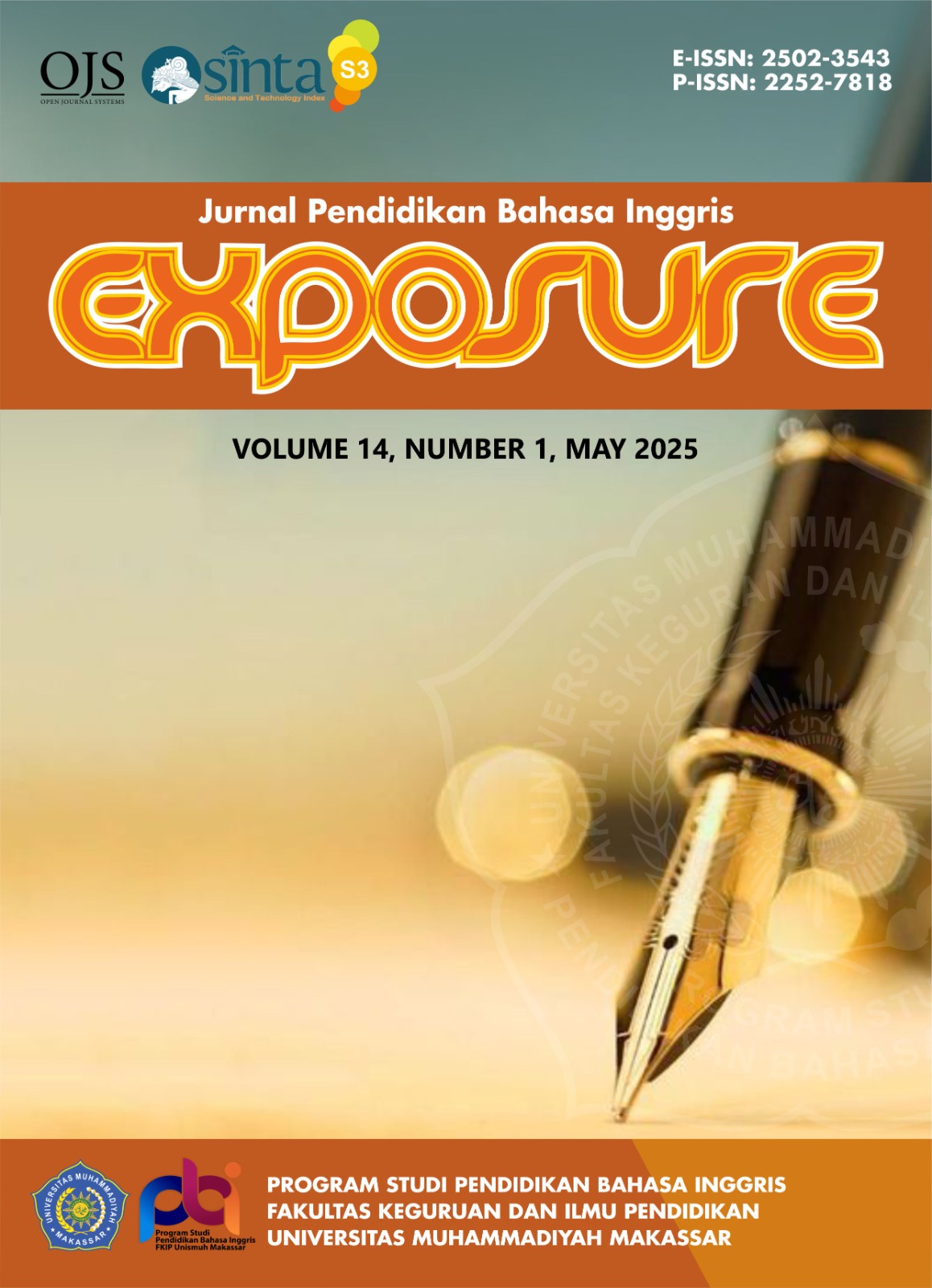THE USE OF POSSE STRATEGY TO DEVELOP READING COMPREHENSION OF THE EIGHTH GRADE STUDENTS OF SMP NEGERI 1 TORIBULU
DOI:
https://doi.org/10.26618/exposure.v14i1.14705Kata Kunci:
Reading Comprehension, POSSE StrategyAbstrak
The objective of the study was to determine the efficacy of the POSSE (Predict, Organize, Search, Summarize, and Evaluate) Strategy in enhancing students' reading comprehension. This study was carried out at the SMP Negeri 1 Toribulu. The research population comprised 66 eighth-grade students. The research used quantitative research, particularly in Quasi-Experimental Design. To get the sample, the researcher employed cluster random sampling. The data was collected using exam items, which included 10 multiple-choice and 5 essay questions. There were pretest and posttest in both groups, and the experimental group received treatment while the control group did not. The results showed the students' mean score of the experimental group (55.64) on the posttest was higher than the score from the control group (31.24) on the posttest. The sig value is calculated using statistical results. With a 2 tailed of 0.000<0.05, it can be determined that there is a significant difference in the mean score of pupils' learning outcomes between the POSSE-based learning model and the usual method taught by the teacher.
Referensi
Arianti, G., & Tiarina, Y. (2014). Teaching Reading Analytical Exposition Text To Senior High School Students By Using Posse (Predict, Organize, Search, Summarize, Evaluate) Strategy. Journal of English Language Teaching, 3(1), 195–201. http://ejournal.unp.ac.id/index.php/jelt/article/view/4376
Englert, C. S., & Mariage, T. V. (1991). Making Students Partners in the Comprehension Process: Organizing the Reading “POSSE.” Learning Disability Quarterly.
Harisma, R., & Karimah, A. N. (2020). The effect of using posse (predict , organize , search , summarize , and evaluate) strategy on the students ’ reading comprehension achievement in descriptive text. Lintang Songo: Jurnal Pendidikan, 3(2), 11–16.
Hutauruk, B. S., Simarmata, R. O., Saragih, M., & Lestari, F. D. (2022). The Effect of POSSE ( Predict, Organize, Search, Summarize, and Evaluate) Strategy to the Students’ Ability in Reading Comprehension at Grade I in SMA Swasta Taman Siswa. 8(2), 183–199.
Jameel, A. S. (2017). The Effectiveness of P.O.S.S.E Strategy on Improving Reading Comprehension of the EFL University Students. International Journal of English Literature and Social Sciences, 2(4), 123–133. https://doi.org/10.24001/ijels.2.4.15
Jhon, C., & David, C. (2019). Research Design: Qualitative, Quantitative, and Mixed Methods Approaches. New Horizon in Adult Education & Human Resource Development, 31(3), 75–77. https://doi.org/10.1002/nha3.20258
Mertosono, S. R., Erniwati, E., Hastini, H., & Arid, M. (2020). Using POSSE Strategy in Teaching Reading Comprehension. Ethical Lingua: Journal of Language Teaching and Literature, 7(2), 321–328. https://doi.org/10.30605/25409190.214
Prasetyo, A. (2019). Improving Reading Comprehension Ability by Using Guide Reading and Summarizing Procedure (GRASP) Strategy Among the Eighth Graders of SMPN 1 Batanghari in The Academic Year 2019/2020. State Islamic Studies, 5(2), 230–235.
Tarchi, C. (2017). Comprehending Expository Texts: The Role of Cognitive and Motivational Factors. Reading Psychology, 38(2), 154–181. https://doi.org/https://doi.org/10.1080/02702711.2016.1245229
Unduhan
Diterbitkan
Terbitan
Bagian
Lisensi
Authors who publish with this journal agree to the following terms:
In order to assure the highest standards for published articles, a peer review policy is applied. In pursue of the compliance with academic standards, all parties involved in the publishing process (the authors, the editors and the editorial board and the reviewers) agree to meet the responsibilities stated below in accordance to the Journal publication ethics and malpractice statement.
Duties of Authors:
- The author(s) warrant that the submitted article is an original work, which has not been previously published, and that they have obtained an agreement from any co-author(s) prior to the manuscript’s submission;
- The author(s) should not submit articles describing essentially the same research to more than one journal;
- The authors(s) make certain that the manuscript meets the terms of the Manuscript Submission Guideline regarding appropriate academic citation and that no copyright infringement occurs;
- The authors(s) should inform the editors about any conflict of interests and report any errors they subsequently, discover in their manuscript.
Duties of Editors and the Editorial Board:
- The editors, together with the editorial board, are responsible for deciding upon the publication or rejection of the submitted manuscripts based only on their originality, significance, and relevance to the domains of the journal;
- The editors evaluate the manuscripts compliance with academic criteria, the domains of the journal and the guidelines;
- The editors must at all times respect the confidentiality of any information pertaining to the submitted manuscripts;
- The editors assign the review of each manuscript to two reviewers chosen according to their domains of expertise. The editors must take into account any conflict of interest reported by the authors and the reviewers.
- The editors must ensure that the comments and recommendations of the reviewers are sent to the author(s) in due time and that the manuscripts are returned to the editors, who take the final decision to publish them or not.
Authors are permitted and encouraged to post online a pre-publication manuscript (but not the Publisher’s final formatted PDF version of the Work) in institutional repositories or on their Websites prior to and during the submission process, as it can lead to productive exchanges, as well as earlier and greater citation of published work (see The Effect of Open Access). Any such posting made before acceptance and publication of the Work shall be updated upon publication to include a reference to the Publisher-assigned DOI (Digital Object Identifier) and a link to the online abstract for the final published Work in the Journal.




